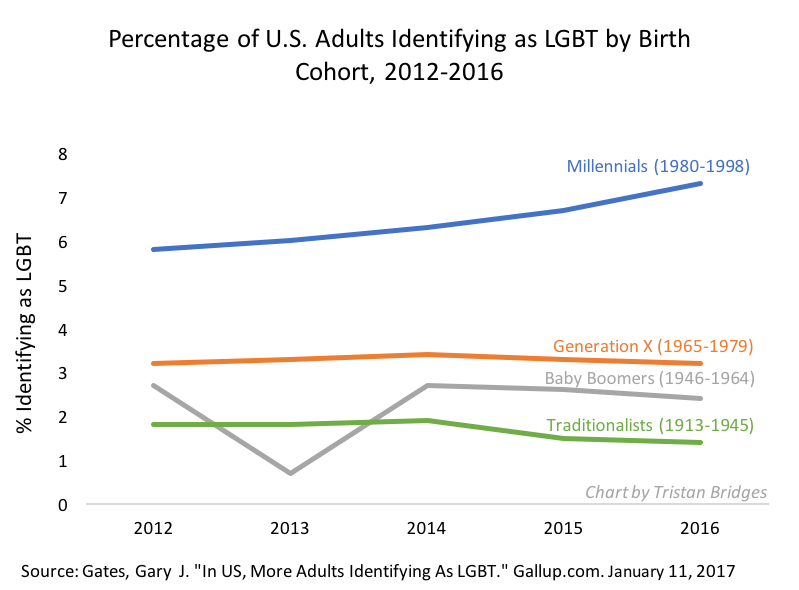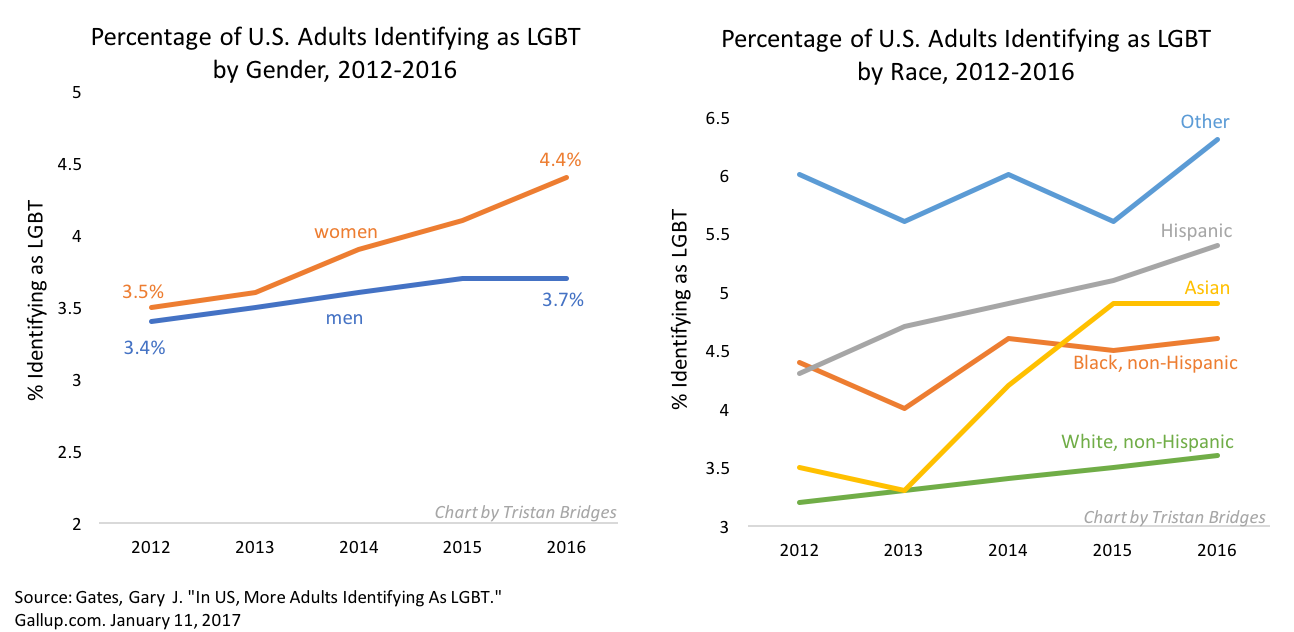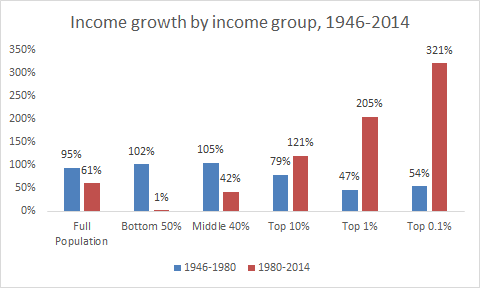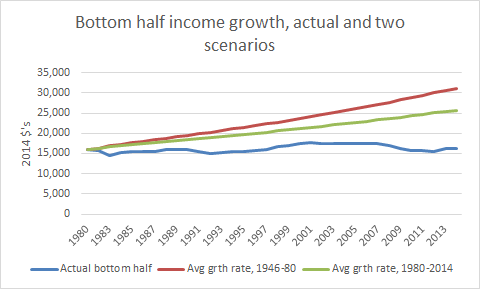Originally posted at Made in America.
Explaining how such an unfit candidate and such a bizarre candidacy succeeded has become a critical concern for journalists and scholars. Through sites like Monkey Cage, Vox, and 538, as well as academic papers, we can watch political scientists in real time try to answer the question, “What the Hell Happened?” (There are already at least two catalogs of answers, here and here, and a couple of college-level Trump syllabi.) Although a substantial answer will not emerge for years, this post is my own morning-after answer to the “WTHH?” question.
 I make three arguments: First, Trump’s electoral college victory was a fluke, a small accident with vast implications, but from a social science perspective not very interesting. Second, the deeper task is to understand who were the distinctive supporters for Trump, in particular to sort out whether their support was rooted mostly in economic or in cultural grievances; the evidence suggests cultural. Third, party polarization converted Trump’s small and unusual personal base of support into 46 percent of the popular vote.
I make three arguments: First, Trump’s electoral college victory was a fluke, a small accident with vast implications, but from a social science perspective not very interesting. Second, the deeper task is to understand who were the distinctive supporters for Trump, in particular to sort out whether their support was rooted mostly in economic or in cultural grievances; the evidence suggests cultural. Third, party polarization converted Trump’s small and unusual personal base of support into 46 percent of the popular vote.
Explaining November 8, 2016
Why did Donald Trump, an historically flawed candidate even to many of those who voted for him, win? With a small margin in three states (about 100,000 votes strategically located), many explanations are all true:
* Statistical fluke: Trump won 2.1 percentage points less of the popular vote than did Clinton, easily the largest negative margin of an incoming president in 140 years. (Bush was only 0.5 points behind Gore in 2000.) Given those numbers, Trump’s electoral college win was like getting two or three snake-eye dice rolls in a row. Similarly, political scientists’ structural models–which assume “generic” Democratic and Republican candidates and predict outcomes based on party incumbency and economic indicators–forecast a close Republican victory. “In 2012, the ‘fundamentals’ predicted a close election and the Democrats won narrowly,” wrote Larry Bartels. “In 2016, the ‘fundamentals’ predicted a close election and the Republicans won narrowly. That’s how coin tosses go.” But, of course, Donald Trump is far from a generic Republican. That’s what energizes the search for a special explanation.
* FBI Director Comey’s email announcement in the closing days of the election appeared to sway the undecided enough to easily make the 100,000 vote difference.
* Russian hacks plus Wikileaks.
* The Clinton campaign. Had she visited the Rust Belt more, embraced Black Lives Matter less (or more), or used a slogan that pointed to economics instead of diversity… who knows? Pundits have been mud-wrestling over whether her campaign was too much about identity politics or whether all politics is identity politics. Anyway, surely some tweak here would have made a difference.
* Facebook and Fakenews.
* The weather. It was seasonably mild with only light rain in the upper Midwest on November 8. Storms or snow would probably have depressed rural turnout enough to make Clinton president.
* The Founding Fathers. They meant the electoral college to quiet vox populi (and so it worked in John Q. Adams’s minus 10 point defeat of Andrew Jackson in 1824).
* Add almost anything you can imagine that could have moved less than one percent of the PA/MI/WI votes or of the national vote.
* Oh, and could Bernie would have won? Nah, no way, no how. [1]
Small causes can have enormous consequences: the precise flight of a bullet on November 22, 1963; missed intelligence notes about the suspicious student pilots before the 9/11 attacks; and so on. Donald Trump’s victory could become extremely consequential, second only to Lincoln’s in 1860, argues journalist James Fallows, [2] but the margin that created the victory was very small, effectively an accident. From an historical and social science point of view, there is nothing much interesting in Trump’s electoral college margin.
Trump’s Legions
More interesting is Trump’s energizing and mobilizing so many previously passive voters, notably during the primaries. What was that about?
One popular answer is that Trump’s base is composed of people, particularly members of the white working class (WWC), who are suffering economic dislocation. Because their suffering has not been addressed, they rallied to a jobs champion.
Another answer is that Trump’s core is composed of people, largely but not only WWC, with strong cultural resentments. While often suffering economically and voicing economic complaints, they are mainly distinguished by holding a connected set of racial, gender, anti-immigrant, and class resentments–resentments against those who presumably undermined America’s past “greatness,” resentments which tend to go together with tendencies toward authoritarianism (see this earlier post).
The empirical evidence so far best supports the second account. Indicators of cultural resentment better account for Trump support than do indicators of economic hardship or economic anxiety. [3]
In-depth, in-person reports have appeared that flesh out these resentments in ways that survey questions only roughly capture. They describe feelings of being pushed out of the way by those who are undeserving, by those who are not really Americans; feelings of being neglected and condescended to by over-educated coastal elites; feelings of seeing the America they nostalgically remember falling away. [4]
 Defenders of the economic explanation would point to the economic strains and grievances of the WWC. Those difficulties and complaints are true–but they are not new. Less-educated workers have been left behind for decades now; the flat-lining of their incomes started in the 1970s, with a bit of a break in the late 1990s. Moreover, the economy has been in an upswing in the last few years; the unemployment rate was about 8 percent when Obama was re-elected in 2012, but about half of that when Trump was elected. Economic conditions do not explain 2016.
Defenders of the economic explanation would point to the economic strains and grievances of the WWC. Those difficulties and complaints are true–but they are not new. Less-educated workers have been left behind for decades now; the flat-lining of their incomes started in the 1970s, with a bit of a break in the late 1990s. Moreover, the economy has been in an upswing in the last few years; the unemployment rate was about 8 percent when Obama was re-elected in 2012, but about half of that when Trump was elected. Economic conditions do not explain 2016.
Nor are complaints about economic insecurity new. For example, the percentage of WWC respondents to the General Social Survey who said that they were dissatisfied with their financial situations has varied around 25 percent (+/- 5 points) over the last 30 years. The percentage dissatisfied did hit a high in the early years of the Great Recession (34 percent in 2010), but it dropped afterwards (to 31% in 2012 when Obama was re-elected and 29% in 2014). Economic discontent has been trending down, not up. [5] That only one-fifth of Trump voters supported raising the minimum wage to $15 further undercuts the primacy of economic motives.
To be sure, journalists can find and record the angry voices of economic distress; they do so virtually every election year. (Remember the painful stories about the foreclosure crisis and about lay-offs during the Great Recession?). There was little distinctive about either the economic distress or the economic anxiety of 2016 to explain Trump.
Some have noted, however, what appear to be a significant number of voters who supported Obama in 2008 or in 2012 and seemed to have switched to Trump in 2016 (e.g., here). Do these data not undermine a cultural, specifically a racial, explanation for Trump? No. In 2008, Obama received an unusual number of WWC votes because of the financial collapse, the Iraq fiasco, and Bush’s consequent unpopularity. These immediate factors overrode race for many in the WWC. But WWC votes for Obama dropped in 2012 despite his being the incumbent. Then, last November, the WWC vote for a Democratic candidate reverted back to its pre-Great Recession levels. [6] Put another way, Clinton’s support from the WWC was not especially low, Obama’s was unusually high for temporary reasons.
What was special about 2016 was the candidate: Donald Trump explicitly and loudly voiced the cultural resentments and authoritarian impulses of many in the WWC (and some in the middle class, too) that had been there for years but had had no full-throated champion–not Romney, not McCain, not the Bushes, probably not even Reagan–since perhaps Richard Nixon. What changed was not the terrain for a politics of resentment but the arrival of an unusual tiller of that soil, someone who brought out just enough of these voters to win his party’s nomination and to boost turnout in particular places for the general election. As one analyst wrote, “Trump repeatedly went where prior Republican presidential candidates were unwilling to go: making explicit appeals to racial resentment, religious intolerance, and white identity.”
But this is still less than half the story.
Party Polarization
To really how understand how Trump could get 46 percent of the vote, it takes more than identifying the distinctive sorts of people whom Trump attracted, because they are not that numerous. Trump won only a minority of the primary votes and faced intense opposition within his party. In the end, however, almost all Republicans came home to him–even evangelicals, to whose moral standards Trump is a living insult. The polarization of American politics in recent years was critical. Party ended up mattering more to college-educated, women, and suburban Republicans than whatever distaste they had for Trump the man.
Consider how historically new this development is. In 1964, the Republican nominee, Barry Goldwater, was considered to be at the far right end of the political spectrum. About 20 to 25% of Republicans crossed over and voted for Democrat Lyndon Johnson. (This crossover was mirrored by Democrats in the 1972 election. [7]) In 2016, by contrast, fewer than 10% of Republicans abandoned Trump–a far more problematic candidate than Goldwater–so much has America become polarized by party in the last couple of decades. [8]
Conclusions
Readings of the 2016 election as the product of a profound shift in American society or politics are overblown. In particular, notions that the WWC’s fortunes or views shifted so substantially in recent years as to account for Trump seem wrong.
What about the argument that the Trump phenomenon is part of a general rise across the western world of xenophobia? I don’t see much evidence outside of the Trump case itself for that in the United States. Long-term data suggest a decline–too slowly, for sure–rather than an increase in such attitudes.[9] And let’s not forget: Hillary Clinton won the popular vote.
The best explanation of why Trump got 46% of the ballots: Advantages for the out party in a third-term election + Trump’s unusual cultural appeal to a minority but still notable number of Americans + historically high party polarization. That Trump actually won the electoral college as well is pretty much an accident, albeit a hugely consequential one.
NOTES____________________
[1] Basically no one, including Trump, said anything bad about Bernie Sanders from the moment it became clear that Sanders would lose the primaries to Clinton. Had he been nominated, that silence would have ended fast and furiously. Moreover as the always astute Kevin Drum pointed out, Sanders is much too far to left to get elected, even way to the left of George McGovern, who got creamed in 1972. Finally, the “Bernie Brothers” who avoided Clinton would have been more than outnumbered by Hillary’s pissed-off sisters if she had been once again displaced by a man.
[2] On the other hand, economist-blogger Tyler Cowen is skeptical: If the doomsayers are right, why aren’t investors dumping equities, shorting the market, or fleeing to safer commodities?
[3] See these sources: 1, 2, 3, 4, 5, 6.
[5] My analysis of the GSS through 2014. White working class is defined as whites who have not graduated college.
[6] Again, I used the GSS. In 2000 and 2004, the Democratic candidates, Gore and Kerry, got about 35 percent of the WWC vote, about what Bill Clinton got in his first run in 1992. Obama got substantially more, 48%, in 2008, then somewhat less, 42%, in 2012. Hillary Clinton got, according to a very different sort of survey, the exit polls, 29% of the WWC, but it is hard to compare the two methods. Note that the GSS reports of who people voted for in the previous election tend to skew toward the winners, but the point still stands that Obama’s jump in support from the WWC, especially in 2008, was quite unusual, not Hillary Clinton’s apparent slump in support.
[7] According to Gallup’s last poll before the 1964 election, 20% of Republicans were going to vote for Johnson. According to my analysis of the American National Election Survey, which is retrospective, 26% actually did. In 1972, the Democrats nominated the most left-leaning candidate of postwar era. According to Gallup data, 33% of Democrats crossed over to vote for Nixon. ANES data suggest that about 40 percent did. Whatever the specifics, there was much more cross-over voting 40 to 50 years ago, even under milder provocation.
[8] On the decline of ticket-splitting, see here.
[9] For example, one of the longest-running items in the GSS is the question, “I’d like you to tell me whether you think we’re spending too much money … too little money, or about the right amount … improving the conditions of Blacks.” In the 1970s, 28% of whites said too much; in the 2000s, 19% did. Another question was asked only through 2002: “Do you agree or disagree… (Negroes/blacks/African-Americans) shouldn’t push themselves where they’re not wanted?” In the 1970s, 74% of whites agreed; from 1990 to 2002, 15% did. More striking, in the 1970s, 11% of whites “strongly disagreed”; from 1990 to 2002, 32% did. On immigrants: David Weakliem has graphed responses to a recurrent Gallup Poll question, “Should immigration be kept at its present level, increased or decreased?”. From 1965 to the mid-1990s, the trend was strongly toward “decreased,” but since then the trend has strongly been toward “increased” (although that’s still a minority view).
Claude S. Fischer, PhD is a sociologist at UC Berkeley and is the author of Made in America: A Social History of American Culture and Character. This post originally appeared at his blog, Made in America.

 We may be more connected through Mario, but that connection takes place within a global capitalist economy. In fact,
We may be more connected through Mario, but that connection takes place within a global capitalist economy. In fact, 









 Recently Nadya Tolokonnikova was
Recently Nadya Tolokonnikova was